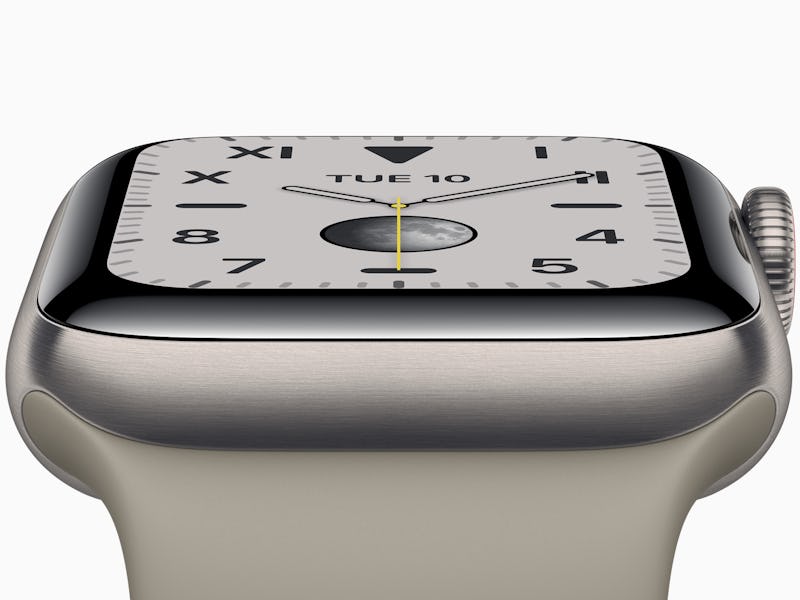Apple Watch Series 5 Finally Solves the Gadget’s Biggest Problem
It's time for a big new feature.

The Apple Watch has finally received a much-needed feature. On Tuesday, Apple announced that the fifth-generation smartwatch would pack an always-on display, enabling users to tell the time without having to activate the screen first.
“The new always-on display is just loaded with advanced technologies,” Stan Ng, vice president of product marketing for the Apple Watch, said during the iPhone 11 unveiling event at the Steve Jobs Theater in Cupertino, California.
For the first time in the device’s five-year history, the Apple Watch now displays the time at all times — battery life permitting. Before, the watch would be an empty black void on the wearer’s wrist, until flicked up with a pronounced motion or activated with a tap of the buttons, crown or screen.
It sounds like a small change, but it taps into Apple’s philosophy of making intuitive products that feel natural to the user. Reviewers like John Gruber have noted that the wrist-flick gesture is somewhat unnatural for watch-wearers used to just looking down and checking their watch for the time, occasionally requiring a somewhat dramatic movement to wake the screen.
Besides usability, the old setup made for a slightly odd look on the wearer’s wrist. Until activated, the watch had no face at all. That meant choosing a new watch face was fine, but by and large, it wouldn’t really change your look in terms of fashion. Most times that people looked at you, all they would see on your wrist was a black square-shaped hole. For a watch that sells itself on fashionable Hermes leather bands and high-end titanium casings, the switched-off screen was something of a distraction.
Inverse highlighted an always-on display in May 2019 as one of the key ways Apple could improve the watch. With the new update, the Apple Watch is set to finally look, act and feel like a real watch.
The Apple Watch's always-on screen in action.
Apple Watch Series 5: How the Always-On Screen Works
An always-on smartwatch screen is nothing new. Indeed, The Verge’s 2015 review of the original Apple Watch noted how it lacked the feature when compared to the Pebble or the LG G Watch R. Both of these had various limitations. For the Pebble, it was using an e-ink display similar to an Amazon Kindle, offering seven-day battery life but without the Apple Watch’s vivid colors. For the G Watch R, its display was powered by a battery in a case so chunky it was larger than the Moto 360.
The new Apple Watch could provide the answer. Apple claims it offers the same 18 hours of power as its predecessor. The specifications state that Apple conducted the tests in August 2019 using pre-release software and hardware, paired with an iPhone. Your mileage could vary.
The screen uses what Ng claimed is “the industry’s only” low-temperature polysilicon and oxide display, also known as an LTPO display. This, PCWorld explained, is a technology that mixes low-temperature polycrystalline silicon thin-film-transistors found in regular displays, and combines it with the cutting-edge indium gallium zinc oxide thin-film transistors found in some iPads and MacBooks.
Apple Watch Series 5, now with a compass.
The difference, analysis firm IHS Markit explained in August 2018, is they both have different strengths. The LTPS transistors offer better threshold voltage performance, a key aspect in power efficiency, but the IGZO transistors offer better support for lower frequencies. That makes the latter technology ideal for slower-changing time displays. IHS Markit noted that Apple applied for three LTPO patents in 2014, 2015 and 2018 respectively.
The LTPO, Apple explains, enables a dynamically-shifting refresh rate that adapts to the situation. When the wrist is raised, the watch updates the screen 60 times per second like every previous generation of the Apple Watch. When it’s lowered, the LTPO display shifts to update just once every second — ideal for telling the time.
The screen is paired with a new ambient light sensor that adapts the brightness accordingly, a power management integrated circuit, and a new low-power display driver.
“By combining this incredible hardware with innovative software, we’re able to deliver this always-on display while still maintaining the same all-day 18-hour battery life,” Ng said.
The software works in conjunction with this new screen by providing a tweaked interface when the wrist is lowered. Watch faces dim, so users don’t walk around with a big block of color shining out of their wrist. With the OLED display, switching a pixel to black switches it off entirely, meaning these new interfaces use the screen’s display to their advantage.
Ng showed how the watch faces move from their active mode…
The watch faces in their active state.
…to a more ambient always-on mode.
The watch faces in ambient mode.
Apple started its presentation by highlighting the health aspects of its latest smartwatches. But with this new display, Apple may have also made its smartwatch more of a watch.